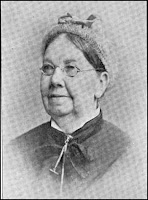Thomas Worrell Family and Mill
Worrell Woolen Mill and House |
It's kind of funny sometimes when I go to write a post, how much variation there can be in the amount of information I'm able to find about different topics. Sometimes there's so much that it's difficult to pare it down to a blog post sized amount; sometimes there's not much, but enough to tell the story well enough; and sometimes, like with this one, I really wish I could find out more, but it just doesn't seem to be there (at least, not yet). Thomas Worrell (or sometimes incorrectly, Worrall) was a name that I neither knew nor was looking for, before it popped out at me while doing research on another topic. I had remembered seeing the name on the Beers map (although it actually looks to be "T. Werrall" on the map), but I didn't know anything about him or his family, and didn't remember seeing the name come up anywhere else. The only thing I did know was that across from his home along Mill Creek, there was a woolen mill. Now, after finding a little bit here and there, I wish I did know more about the Worrell family.
Thomas Worrell, a Quaker, was born in Pennsylvania in 1808, and married Miriam C. Lamborn in 1833. The following year, their first child, Emma, was born. In about 1840, the Worrells moved to Delaware when Thomas purchased a woolen mill on Mill Creek, just south of the Mendenhall Mill. (They did have Delaware ties before that, though, as Miriam was raised in Wilmington, where her father owned a clothing store.) I'm not sure how old the mill was at that time, but it does appear that there is one shown at the location on an 1820 map, owned at that time by a man named Dixon (the mill, not the map). Also unclear is whether the mill was already used for textiles, or whether Worrell converted it for a woolen mill. In either case, it doesn't seem as if it was ever a very large operation. The mill's products were described as "carpet yarn and common goods for home use". During the Civil War, though, the mill produced kersey, a thick woolen cloth that was sold to the US Army to be used for overcoats. Aside from that, Worrell's products were primarily sold in the South, which is interesting because of the other notable thing we know about Worrell -- he was a staunch and active abolitionist.
The Worrells, like many Friends of their day, were outspoken on a number of social issues. First and foremost, they were strongly anti-slavery. They not only didn't hide their beliefs (even Thomas, who was able to maintain the respect of his Southern customers), but they actively worked to make their world a better place for all. Both Thomas and Miriam attended anti-slavery conventions, and Thomas worked closely with high-level abolitionists like William Lloyd Garrison and Wilmington's Thomas Garrett. The Worrells even went a step further, risking their own safety to use their Mill Creek home as a safe-house on the Underground Railroad. Their house, seen in the upper right of the above picture and in the picture below, still stands on the east side of Mill Creek Road. The mill, which was located on the opposite side of the road, is long gone. Sometime in the late 1860's, Worrell sold the mill to Englishman George Gibson, who operated it until probably later in the 1870's. The picture above was taken about 1895, so the mill stood at least that long. I don't know when the larger section came down, but there is a house on the west side of the road that I believe may have been part of the mill (the leftmost structure in the top picture).
The Worrells were far from done when they left Mill Creek Hundred, however. After moving into a home on Washington St. (only a few blocks from the Wilmington Friends Meeting House and school), Thomas and Miriam remained very involved in Quaker meetings. There was also one other cause that was dear to the family -- education. When you think of their other passion, it should come as no surprise that Thomas was a strong advocate for educational opportunities for the black citizens of Delaware. His daughter Emma was deeply involved in education, as well. She was a teacher and principal for many years at the Wilmington Friends School, along with being one of the leaders of the women's suffrage movement in Delaware. On the business side, Emma's brother Granville started as a bank clerk, then in 1861 began a dry goods business that would last until about the end of the century. It's interesting to note that his specialty was carpets, perhaps learned from watching his father manufacture the raw materials for them.
 |
| Emma Worrell (right) and Emalea Pusey Warner |
 |
| Miriam C. Worrell |
Although they only spent about 30 years as Mill Creek Hundred residents, the Worrells are certainly an interesting part of our history. The tidbit about their house being used on the Underground Railroad is what first drew my attention, but the more I learned about them, the more interesting they became. I now see that Thomas Worrell and his family are easily one of the more noteworthy clans to ever live in our area.





Comments
Post a Comment